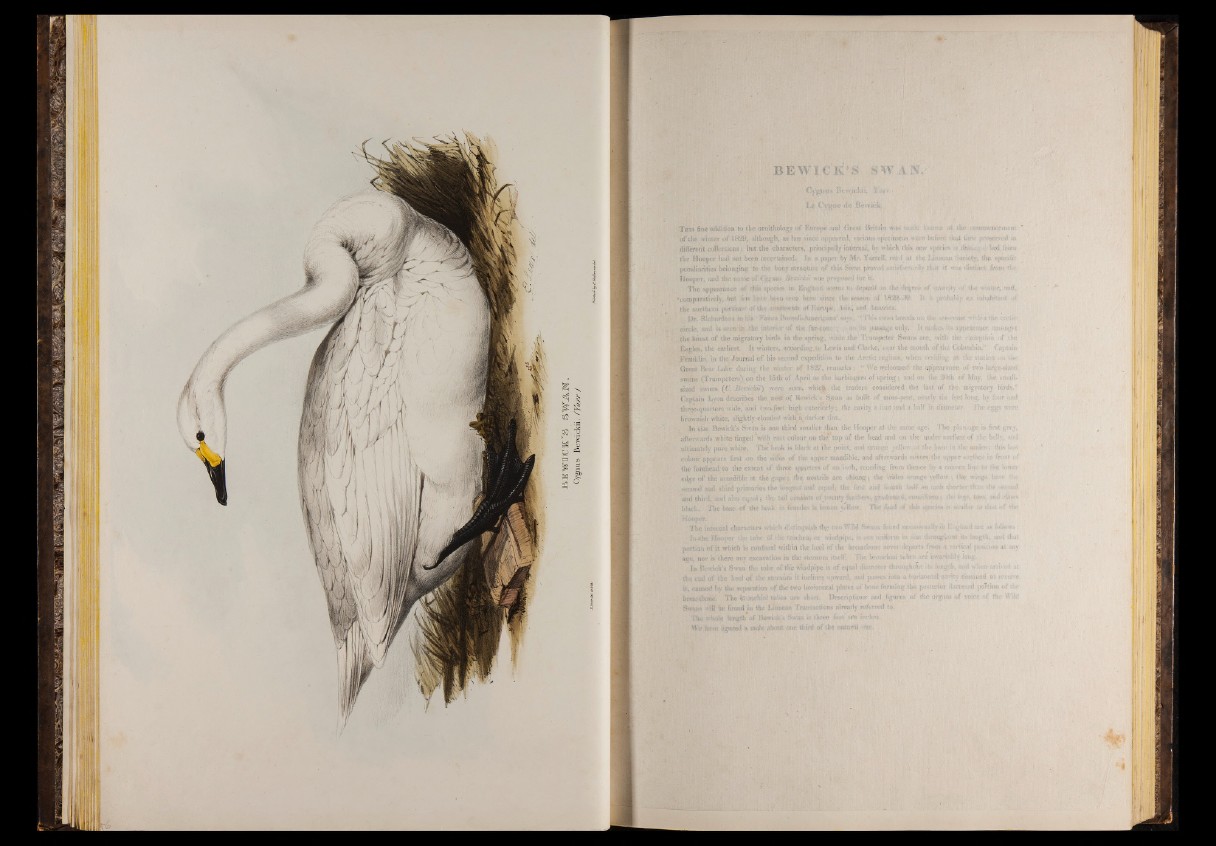
B K W I C K ’ S § ¥ A H
B E W I C K ' S SW A N
Bewjclc«» -I/;«“'..
L é C y g n c d e Bésviôfc.
This fine addition to the ornithology of Europe and Great Britain mas. made know.»' at tl
o f tlio winter of 1829, although, as has since appeared, various sjfeciiaens were before dial. preservcd-in
different collections ; hot the characters, principally internal, by which this new species « nisit,.*. - bed. from
the Hooper had not been useprfomed; I» a paper by Mr. Yarroll, reed at the Lpuiean Society, the specific
peculiarities belonging to the bony structure of this Swan proved aatisi.wtinily that it was distinct from the
Hooper, and the iiauae of! BewirkH was proposed for ht
The appearance of ehà» specie# in EngitU'O seems to dcgMwOl on the degree of w e rô y o f the winter, aud,
’comparatively, httf four S*®*« beet* sewn bens since the season atf 1829. it fa probably ma iithubitoot «f
thé nojrtberii pufs-iir,.» at the • • t •> i,s f of Europe, ï • and Aiwwic*.
Hr. Htchnrd»:»:» *» hi« ! ]Pfeu«ta iforeaH-Aineripa»*»' says,, ‘This swan breeds on tin,- seft-coast within the arctic
circle, and 1® seen in .the interior of the furr-eouc., ... on its passage only. It makes its apj^earancr amongst
the latest o f the migratory birds in the spring, while the Trumpeter Swans are, with. the exception of the
Eagles, the earliest. It winters, according.to Lewis and Clarke, near the taouth of the Columbia.’ Captain
Franklin, in the Journal of his-second cxjiedition to the Arctic regions, when, residing at the station <>
Great Bear Lake duriusi the winter of 1827, remarks : •* We welcomed the appearance of two large-sized
swans (Trutrrpeters) on the 15th of April as the harbingers of springy foul on the 29th of May,, the. small*
sized -swans (C. Bewidcu) were seen, which the traders considered the last of the- migratory birds.”
Captain Lvon describes the nest of Bewick’s, Swan as built o f. mossi-peat, nearlysix feet long, by four and
thr^e-quarters wide, and two. feet high exteriorly ; the cavity a foot ¡and a half in diameter. .Flic eggs were
brownish white, slightly-clouded vrith-a darker tint..
In size Bewick’s Swàn is onfe third smaller than die Hooper ai\tp.e same'age; The plumage is first grey,
afterwards .white1 tinged with rust colour on the top of the head and on the under surface of the belly, an
ultimately pure white. The beak is black at the point, and orange yellow air the base in the males ; this lap;
colour appears first on the sides of the upper tnandihle, and afterwards covers.- the upper surface in front of
the forehead to the extent of three quarters of an inch, receding from thence by a cobs ex line to the lower
edge o f the inaudible àt the gape ; the nostrils are oblong ; the trides orange yellow ; flu* wmgs ! i
.second and third primaries-the longttsbaml equal,■ the first and li'itrth half an isdr fourtwdt3?t tht) '*feeond
and’ third,.and also equal ; th<; tail eÔWpfate ofiWebtÿ Iwéçtlfra, gjtwhWtefL cin^sfowt* ; lV Ifi^i on-:- mi
black. The baie, o f thé beak, in' fomales fa, fenww yellow; I f e ¡$¿$0. o f .¡¡W* fcpWfM h ' similar 5® of the
The internal characters which dîsîîngiiish tlje two Wild Sw ai« fotiiid-ee«afoos»%:iik Bagfaod are as, foilow?
|n 4 h e liooper thé 6uhc ô f ,tlïC ttactieatï or windpipe, is not uniform iu iàiGe throughout its length, and that
portion of it which is confined within tlie keel o f the brcasftbone never departs from a vertical position at any
age, nor is there any excavation in the sternum itself. The bronchia; tidfCfi ><x. inva-e■■.:■■!. ion;.
In Bewick’s Swan the ¡aha oftKe Windpipe is of equal diameter througkowt us length, mid when-arrived at
•• the cod of the keel of die sternum it inclines upward, and passes into a horizontal cavity destined to receive
it, eattsed bv the separation of the two hommital plates of bone forming the posterior flattened portion of the
breastbpée. The hionchiid tubus arc short. Descriptions' and figure» of the qrgaris o f voice of the Wilt!
Swans 'viiî be found in the IJhneaa Transactions -already .referred to,
Thé whole length o f Bewick » Swan is three feet teh inches,
lilllfr tin.ic iigttjied a .nMile aboaf one third of the natural ffaet.